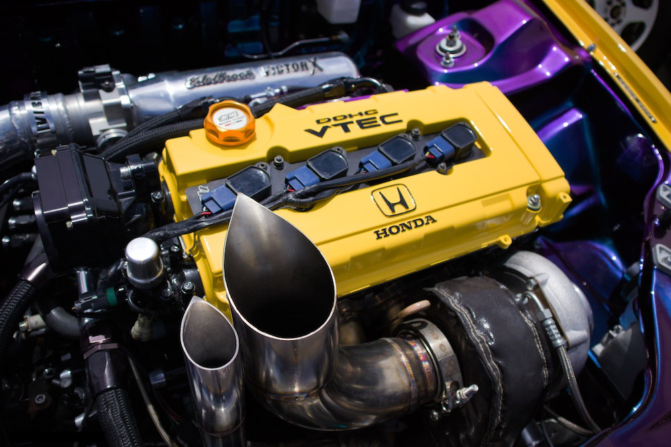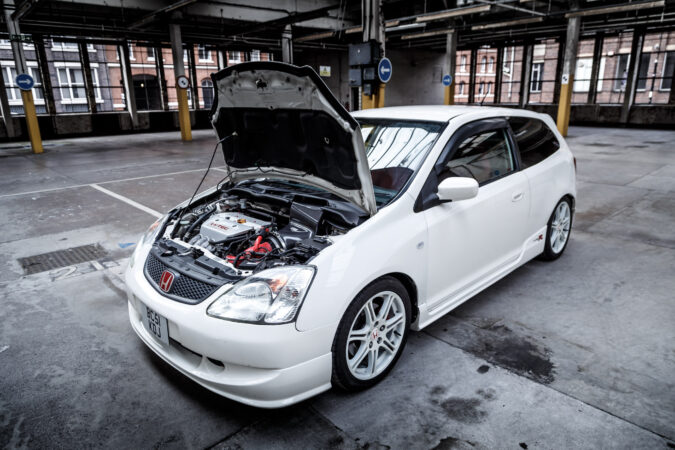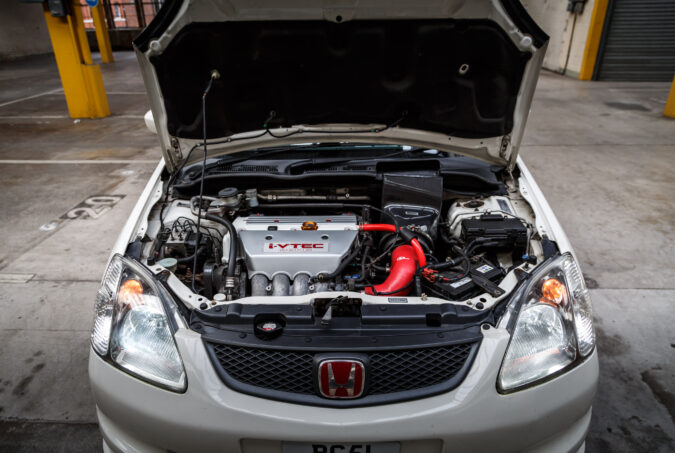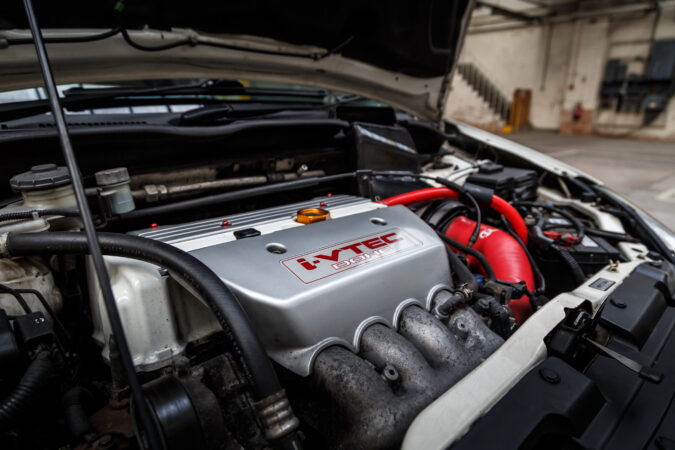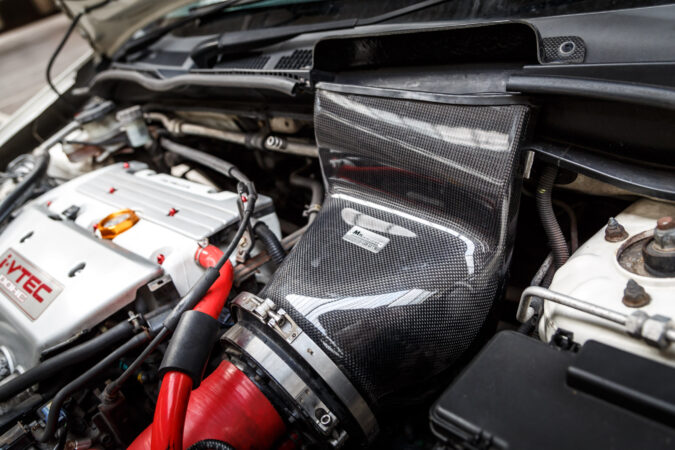In the much-loved Fast and Furious series, a Spoon engine is mentioned. When he gets knocked down and confronted by Dom and his gang, one of Brian’s lines in the very first film goes as follows –
“Hector is going to be running three Honda Civics with Spoon engines. And, on top of that, he just went into Harry’s and he ordered three T66 turbos with NOS. And a MoTeC exhaust.”
This is a sentence that is just laden with automotive brands and terminology. But have you ever wondered what a Spoon engine actually is? And is any of this stuff even real?
Well, spoilers! Yes.
In this article, we will be exploring, in detail, what a Spoon engine is and where you can get your hands on one.
Although your mind might conjure up the image of two inline engines somehow cuddled up to each other (just a little spooning joke for you there – sorry), unfortunately, that’s not the case.
It might sound like something from the world of films. You might even doubt whether or not Spoon engines are real. Well, we’re here to put the issue to bed.
- What is a Spoon Engine
- How is a Spoon Engine Made
- Spoon Engine Cost
- Spoon Engine Models
- Spoon vs OEM Engine
- FAQs
What Is A Spoon Engine
A Spoon engine is a real thing. And, if you want, you can get your hands on one.
Spoon engines get their name from the manufacturer – Spoon Sports. Spoon Sports sells state-of-the-art new aftermarket parts, developed through its own research, whilst also running Type One: a “one-stop auto shop” where customers can take their cars for maintenance and modification. The Type One shop is just over the road from the Spoon headquarters in Tokyo.
Based in Tokyo, Spoon has been in business for over 40 years. Here is a link to their Japanese and EU websites.
As you might guess, with the company being based in Tokyo, Spoon Sports lives and breathes Honda. All the parts and engines they make are to fit the type of Honda vehicles commonly seen with modifications, such as the S2000, the Civic, the Accord, and so on and so forth.
Spoon engines are hand-made in Japan. We will go into this in more detail in further paragraphs, but for now, all you need to know is that they are built with performance increases in mind.
Therefore, for a car to have a Spoon engine, it, of course, must be a Honda, just like the Civics used in The Fast and the Furious. We have a few thoughts on the film at the end of the article if that’s something you would be interested in reading.
Spoon Sports
In the YouTube clip below, created by Donut Media, the origins of Spoon and the basic “getting started” facts are provided for you. Check it out here!
In short, Tatsuru Ichishima was a man in Japan, aged 33. He used a brand new 3rd generation Honda Civic Hatchback AT. Although it was an economical kind of car, it was built to be fun to drive and was a good foundation for creating a quick car.
Ichishima completely revamped the car, reducing weight, replacing the suspension, and increasing power. Honda was so impressed with Ichishima that they entered into an official partnership with him. This led to Spoon being founded in 1989.
Spoon are known for their racing colors of blue and yellow, a vivid combination that is instantly recognizable in any racing car or any engine bay.
Honda Spoon Engine
A Spoon engine is designed with automobile racing in mind, especially. When we say racing, we mean circuit racing rather than drag racing.
Although drag racing can be immense fun to watch, as a professional sport it isn’t much of a thing outside of the US, where the roads and long history of exciting, high-powered muscle cars have made it one of the most loved sports in American history. Most of the rest of the world, however, upon hearing the word “racing” will think about circuit racing.
Spoon engines are made to be efficient in circuit racing. They are designed to last, be (relatively) economical, and have a smooth power output – as well as being as powerful as possible.
In circuit racing, in particular, it’s important that the engine should be able to last a long time. The lengthy process of balancing and weighing each individual engine component leads to Spoon engines being especially well-known for durability. We will go into this more in further sections of this article.
Spoon engines are used in many different FIA-sanctioned motorsport events and series around the world. As The Fast and the Furious also suggests, some people also have engines from the company running in their modded-out cars.
How Is A Spoon Engine Made
Rather than completely rebuilding everything from scratch, a Spoon engine is relatively similar to the original engine found in the car. Aftermarket Spoon parts will be used to increase performance, but their work should be thought of as a modifying surgery as opposed to a complete transplant.
Spoon engines must be made by Spoon Sports themselves. Although it is technically possible for anyone to purchase all the parts individually and assemble the engine themselves, doing it this way means that it cannot be called a Spoon engine officially.
Spoon engines are basically simply highly modified OEM (Original Equipment Manufacturer) engines. Rather than developing a huge range of their own products, many Spoon parts are simply OEM parts made with lower margins for error. They are more precise, you might say.
Engine parts are balanced and then weighed, to a precision of +/- 0.01 grams (which is as per Honda’s specification). In technical terms, that’s referred to as “really, really precise”. Some also report that all the nuts and bolts will also be torqued to a precision of +/- 1 Nm. Most average torque wrenches that you might find in parts or hardware stores will have a tolerance of about +/- 2 %, which is drastically more than a professional tool.
Why Is A Spoon Engine Made So Precisely
If you aren’t too familiar with racing engines, this might seem just a bit picky. You might think, ‘What difference does a hundredth of a gram make, really? And the most minute change in how a part balances, does that really change anything?’
Spoon engines are designed to be as fast as possible.
As you drive your car faster and faster, the engine is put under more and more strain. If you thrash your car too much too often, something is bound to go wrong, due to the huge internal forces and staggering amounts of heat generated through friction.
To cope with an increased speed (more revs per minute), Spoon engines must be made to very strict guidelines. This makes it less likely to go wrong, whilst also providing better all-round performance.
A Spoon engine will provide better power across the RPM range of a vehicle, rather than just at certain points.
In short, using these high-precision measurements means that the power delivery will be smoother and more intense, whilst also making the engine last longer than it would otherwise. It’s a win/win – and that’s why the whole process can be somewhat… expensive.
We’ll look at what you should expect to pay in just a moment.
When putting together any kind of new vehicle, Spoon is well-known for its engines. They were one of the first to switch to the more-common-nowadays electronic ignition units, which are far easier to tune.
What Is Spoon’s Building Philosophy
When putting a car together, Spoon is also well-known for their work on the following:
- Driveshafts are worked on to make sure that friction is kept to a minimum and that they will have the strength to withstand the increased forces coming from the engine.
- The throttle body must be big enough to allow enough air in for the engine to function at its maximum capacity (but not too big).
- Head gaskets will be under increased amounts of heat and pressure, as the engine will be operating under much greater stresses than the stock version. Therefore, they must be altered to be able to withstand this more hostile environment.
- Brakes – with brakes, it’s often the bigger the better. More accurately, the better at braking, the better… which is quite obvious.
- Aero parts – for ultimate speed and stability, these should increase downforce and yet simultaneously reduce drag.
- Gusset plates, for reinforcing the strength of the vehicle.
Overall, Spoon’s building philosophy is all about balance. And, making sure that each part of the vehicle has a job to do and that it can do it well.
Every part must be useful and be able to work in harmony with the rest of the parts on the car.
If you can get all the parts of a car to work perfectly in harmony, you get the best possible driving experience.
In a nutshell, it’s these thoughts that drive Spoon to create ever more impressive automotive parts and engines.
How Much Is A Spoon Engine
Well. Quite a lot. But perhaps not too much more than a high-quality engine swap.
For the majority of Spoon engines, you’re looking somewhere between $9,000 and $15,000.
So, a Spoon engine is probably only for you if you’re a die-hard racer, Honda or Fast and Furious fan, or a person with lots of cash to have fun with. And we would assume that you’re at least one of them, given that you’re still reading this article.
You could also, if money really isn’t an issue, send your engine off to Spoon to be modified. Sometimes it’s also a good idea to get other sections of the drivetrain modified. This helps them to cope with the increased power output and is definitely worth doing.
Spoon Engine For Sale
If you have a popular Honda model, chances are you’ll be able to get your hands on a Spoon engine that fits it. As we mentioned earlier, Spoon engines are most commonly seen on Civics, S2000s, and Accords, but if you have any Honda that is well-known for its potential to be modified, you’ll probably be alright.
If you’re after specifics, we’ve put together a list of stock Spoon engines that might interest you. These all come from Spoon’s website and are currently available. We have sorted the list by model for your convenience.
- Honda Civic
- B16B engine (overhaul)
- K20A
- Honda S2000
- F20C (2.0 l)
- F20C (2.2 l)
- F22C
- F20C (2.0 l) short block
- F20C (2.2 l) short block
- F22C short block
- Honda Accord
- K20A
- Honda Integra
- B18C (overhaul)
- K20A
- Honda S660
- S07 A
As you might expect with a tuning/aftermarket parts company, there is much more available. Although we are specifically thinking about Spoon engines in this article, you will find a wide range of other high-quality parts on the website.
Spoon Parts
Spoon also produces a wide variety of parts for your car, from thermostats to fully kitted-out engines. They are especially well-known for their brakes and aero systems.
To view the full list of products available from Spoon’s Japanese website, look here. You may need to apply a translation plug-in (such as Google Translate on Chrome) to read the pages. But is worth a look for sure.
If you are looking for a Spoon engine to be built specifically for your racing car but can’t see what you want online, don’t hesitate to get in touch with them. Spoon is all about hand-crafting optimal performance. There’s nothing better than a team of experts coming up with the best possible way to structure the engine for your specific car. If you do go down this route, be prepared to pay quite a bit more.
Spoon Vs OEM
Aside from the fact that they’re more powerful, how does a Spoon engine compare to its standard OEM little brother?
It wouldn’t really be fair to put 2 side by side, because a car is about more than just the statistics. Spoon engines should be thought of in the same way. It’s not just about more power, although that’s what you” undoubtedly get. The concept is more about the smooth delivery of power to the wheels and also allowing the car to comfortably maintain a higher engine speed than stock engines.
To show you rather than tell you, take a look at this YouTube clip. It was posted to YouTube by Kang Wong and shows how an ordinary Civic compared to a Spoon Civic.
You will notice that the main difference between the 2 cars is the increased smoothness and speed of the engine. Putting the 2 cars side by side really helps to emphasize what is going on here, and why people pay so much for a Spoon engine in their car.
Type One
As we mentioned in the introduction, part of the Spoon company is the Type One auto shop. The shop is just over the street from the Spoon headquarters in Tokyo.
In essence, Spoon make the parts, that anyone can buy. But, if you want some real tuning experts to be responsible for putting your car together, you take it to Type One.
In this workshop, parts are meticulously put together with the same sorts of attention to detail and precision that Spoon are well-known for.
Honda Civic Type R
The Honda Civic Type R is worthy of a special mention.
When the original Type R (or, to use its proper name, the EK9) came out, back in 1997, it was a car built for racing. In fact, it was probably one of the sportiest everyday-type cars that Honda had ever made.
This came to the attention of Spoon. The Type R was so good, even in stock form, that it could challenge even some of their highly modified engines for track prestige. Ichishima got hold of a Type R and set to work. Thus, modifying and balancing the engine, removing even more weight from the car. And, adding some bigger, better brakes.
What was the result of this operation?
Well… Brake horsepower increased from 185 bhp to 260 bhp. This represents an increase of 75 bhp and a percentage power increase of about 40%. The rev limit was increased hugely – reaching about 11,000 rpm. Once all the weight had been removed by Ichishima and his company, the finished product weighed less than a tonne – 900 kg all in. And it was all yellow.
Spoon’s Civic Type R was even better than Honda’s, and the company helped to write the car into this history books as one of the most popular street racing cars ever.
Spoon Engine Fast And Furious
Ah, one of the best car guy films of all time. Guaranteed.
Now, it’s possible that you just wanted to read up on your Fast and Furious facts, so we’ve included this short section to address that.
The cars used in the first film – the ones that Brian is referring to in the above scene and that feature all the way through the film – are 1993 Honda Civic EJ1s. They ran B-series 1.8-litre Spoon VTEC engines, along with all the fancy neon lights and extras that Brian talks about.
You can read more about the B-series Honda engines on Wikipedia.
Before Spoon gets to work on any of the B18 engines (you can currently purchase a B18C for an Integra on Spoon’s website), they kick out around 180 – 200 bhp, depending on the exact model. That’s not too shabby. After engine modifications from Spoon, and then including the T66 turbos that Brian spies, you can expect quite a performance boost. This justifies the ability of Toretto and his gang to evade the police for so long, with such high-powered vehicles.
Spoon Engine Facts:
- Spoon Engine is a real thing, and it is manufactured by a company called Spoon Sports.
- Spoon Sports is a Japanese company that produces high-performance engines for various Honda models.
- Spoon Sports has been operating in the industry for more than four decades, and it is one of the largest Honda tuner companies in Japan.
- Spoon Engines are highly-modified, professional-grade Honda engines that could equal racing car engines in terms of power and speed.
- The components of Spoon Engines are refined and balanced OEM Honda parts rather than newly manufactured ones.
- The refining and balancing process of the components improves the engine’s performance, power delivery, and throttle response, making the engine rev faster.
- Spoon Engines are mainly used for circuit racing that demands optimum efficiency without sacrificing the engine’s lifespan and reliability.
- Pro race teams are the main buyers of the Spoon Engines, but anyone with a desire to drive a car with an optimized stock motor can also have the engine.
- Spoon Engines are expensive, and one such motor may cost as much as a new car.
- To get a Spoon Engine, you can either purchase a crate motor or contact Spoon Sports for tuning one for your specific Honda model.
Spoon Engine: In Conclusion…
Spoon engines have an air of mystique about them. The internet is full of different ideas, opinions, and thoughts on how good they are, how to get hold of them, and whether they are worth it or not.
In our opinion, Spoon is the original pedigree of manufacturer-approved Honda modifications. It is a company steeped in humble beginnings and hard work, operating at the cutting edge of modern innovation and engineering.
If you have the money, a Spoon engine could well be the way forward for you. You have the option of purchasing a ready-made engine. Or, if your wallet really is spilling out, you could send your engine (and other drive-train parts) to Spoon. Then, opt for a complete system modification (called an overhaul). The choice is yours.
If none of those are quite right for you, then you might be satisfied with simply ordering a few Spoon parts for installation on your car. That way you get just a hint of what it might be like to do the full thing. And, hey, maybe one day you will.
We hope this article has been useful for you and that you know a little more about Spoon engines.
FAQs On Spoon Engine
If you’re still curious to learn more about what a Spoon engine is, our FAQs here might help…
How Much Are Engines For Cars
If you’re planning to either replace or swap out an engine, it’s not going to be cheap. On average, you could be spending as much as $4,000 on a 4-cylinder engine, and that’s just the bare minimum. V6s and V8s will naturally cost more. However, there are ways that you can reduce the cost of a new engine. For example, some have recommended going for used engines instead of brand new ones. These can be bought from scrapyards for as little as just $500. Although, their quality and condition will be questionable, at best. At the very least, you’re still looking at $1,500 to $2,500 for a decent enough, low-spec engine. Meanwhile, specialty engines are incredibly costly. For example, a highly-tuned Spoon engine for a Honda costs between $9,000 to $15,000.
What’s JDM Stand For
JDM stands for Japanese Domestic Market. In the car world, it refers to vehicles that were built and sold within the domestic, local Japanese car market. Not all Japanese cars are necessarily JDM, though. For example, a Japanese car built in Japan yet sold overseas as an export doesn’t technically qualify as JDM. For example, a Japanese car that was built in Japan and sold for the US market is referred to as a USDM. Typically, these sorts of cars usually carry some differences compared to their JDM counterparts. They might, for instance, have less power compared to a JDM variant to comply with US emissions regulations. On the other hand, you have cars that were built and sold exclusively in Japan only and never sold elsewhere. These are regarded as ‘true’ JDM cars by enthusiasts.
What Is A K20
The K20 is an engine variant within Honda’s legendary K series of engines. Among car enthusiasts, the K20 is well-regarded for its reliability, economical fuel consumption, and relatively low emissions. Yet, the K20 has enormous tuning potential, and some regard it as one of the best engines in the world. The first K20s hit the US market in 2002. From there, it powered iconic performance cars like the Civic Si and Acura RSX. There’s a huge variety of differing K20 variants out there, such as the K20A2 or the K20A3. Each one differs slightly from the other, mainly in how their valvetrains and VTEC systems were integrated. At its peak, the K20 could output more than 300hp. And, being a VTEC engine, the K20 achieves its peak power at super-high RPMs.
What Car Has A K20 Engine
The K20 engine is regarded as one of Honda’s most iconic powerplants. It was reliable, economical, and emissions-friendly, yet extremely potent. Among enthusiasts, the K20 is a favored candidate for extensive tuning and engine swaps owing to its performance potential. As such, the K20 was fitted to an abundance of Honda performance cars. That included the Civic Type R, Integra Type R, RSX Type S, Accord Euro R, and more. Here in the States, we might fondly remember the K20 engines in the Civic Si, Civic SiR, and the Civic Type S. However, the versatility of the K20 engines also made it a perfect fit for more ordinary cars. A bunch of Civics, Streams, Accords, CR-Vs and their Acura equivalents had K20 engines.
What’s A Ricer Car
In the car world, a Ricer is an abbreviation of Race Inspired Cosmetic Enhancement. By definition, Ricer cars are vehicles that have somewhat overdone with their extensive modifications. Specifically, these modifications are mostly cosmetic in nature, such as installing large wings, wide-body kits, or LED under glow. In other words, Ricer cars don’t usually feature any performance benefits, other than their outrageous looks that mimic race cars. Ricer cars are commonly attributed to JDM (Japanese) or other Asian-made cars. Although, the Ricer culture has been adopted onto European or American cars. Originally, the term ‘Ricer’ was considered a racist insult for folks to mock cheaper Japanese and Asian cars.

